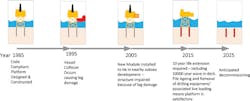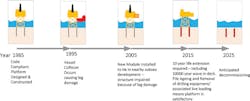Classification agency weighs in on platform life extensions, modifications
Neil Morgan
Lloyd’s Register
Life extension and the modification of existing oil and gas platforms present increasingly significant challenges to the offshore industry and platform designers. Most oil- and gas-producing areas of the world have fixed platform structures that are reaching or have exceeded their original design lives when it is economically beneficial to extend their life because fields are still active. Similarly, modifying an existing platform is an alternative to constructing a newbuild to tie-in other nearby fields.
These practices can present serious challenges to designers: Although it is generally difficult and expensive to modify structures or foundations, these changes are usually required to adhere to regulatory and industry standard requirements. For example, standards may have changed since the original construction - often by becoming more onerous. Furthermore, a platform may have been subject to structural damage during installation or operation; been subject to fatigue or corrosion failure; undergone weight increases during previous modification; or have experienced other degradation such as seabed subsidence due to reservoir extraction.
One increasingly recognized issue is a step-change in environmental loading by events such as a 10,000-year wave-in-deck loading. Not accounted for during the original design; it is now a critical scenario that requires consideration. This article will explore what platform operators and designers can do to address these challenges early in the design process, and manage them during platform modifications or life extension exercises.
Designing within standards
Many existing or newbuild platforms have some sort of unique issue that does not fit comfortably within the usual industry guidelines for offshore platform design, such as API RP2A WSD or the ISO 19900 series of standards. It is important to recognize that standards such as API RP 2A WSD or the ISO 19900 series are a sound starting point for design - in particular for “standard” situations. Rather than the strict interpretation of a code requirement, the industry has a responsibility in using standards to adopt sound engineering practice should this be more suitable. After all, the main aim of a platform structural design process should be a design that is robust and pragmatic. The term robust is used in the sense that a platform must be safe and fit for purpose, yet pragmatic in the sense that due consideration should be given to other aspects such as the practicalities or constructability.
Most standards have basic prescriptive, or normative, requirements that shall be followed in order to achieve a satisfactory design (“shall” is one of the formal words used in ISO standards to indicate a requirement to follow). Standards often then go further to provide more informative guidance that may be used for design. Although other alternatives based upon sound engineering principles may also be used. An example of this is the normative requirement that the pile capacity and factor of safety shall be determined. On the other hand, ISO 19901-4 presents a method that “may” be used if appropriate, but that other methods may be considered if they are better suited. It can be easier to deviate from informative guidance, in a standard or industry practice, if the potential issue is recognized early in the design process and appropriate steps are taken to provide assurance that a robust design will be achieved.
An example of this occurring in a fixed platform site can be found west of Shetland. Here, the extremely hard clays and dense sands in the seabed were outside of normal industry experience, causing some uncertainty regarding whether the informative requirements of the standard or other methods would be more appropriate. These “unconventional soils” were recognized as a potential issue by the platform operator early in the design process: If the design was not conservative enough, then it would be unsafe. If it were too conservative, then it may have been difficult or impossible to install. On this basis, the operator formed an independent foundation assurance team consisting of consultants, academics, and the site investigation contractor and certifier who worked in parallel but independently of the design contractor. The foundation assurance team considered how the informative methods for pile design within the standard could be used with confidence or whether alternative methods were more suitable. An additional task was to determine whether the piles could be installed. The overall result was to establish that the pile design was robust and pragmatic, in accordance with the normative standard requirements and using the informative guidance where it was established to be appropriate. For the successful delivery of a project, it is important that non-standard issues are recognized early in the development process, and that active steps are taken to address them based upon sound engineering practice - rather than people burying their collective heads in the sand.
Overall conservatism
A frequent issue in life extension or modification is to find that either primary structural members or the foundations are predicted by analyses to be unsatisfactory according to basic code requirements. It is rather common to find platforms that theoretically fall short of the target factors of safety required to demonstrate structural stability due to issues that are not fully recognized or understood. Indeed, the word “failure” can cause great concern to all parties involved, including the operator/duty holder, designer, certifier, and regulator. This in particular is found to be the case if the winter storm or cyclone season is fast approaching.
The requirement to consider a 10,000-year-wave and potential wave-in-deck loading are common triggers for a prediction of code non-compliance or failure, as is when the apparent weight or live-loading of a platform has progressively increased throughout its operational life without ever being subject to a rationalization process.
The principal case here is the argument for overall conservatism in a platform design, rather than over-conservatism in every single element of a design. An excessive amount of conservatism in design can introduce an unintended increase in risk exposure, such as the requirement for de-manning and the resultant helicopter transfers when severe weather is predicted, or extra structural inspections. The requirement for overall conservatism introduces a need for project teams to understand what inherent conservatisms are included in the design and how they may be managed should it not be possible to demonstrate the platform structure and foundations are suitable.
An example of this is the amount of weight assumed to be on the topsides for the in-service conditions. On older platforms, there are often some inaccuracies surrounding the drilling rig. Sometimes the unit will be included when it was actually removed years earlier, or in another case, the rig is present, but is seen as unlikely to be used in the foreseeable future and therefore removed.
It is often the case that such allowances are left in as a contingency by the operator or project team, without being recognized later in the design process as an opportunity to remove conservatism with the result that a structure could then be demonstrated to be satisfactory; or at least be not as bad as people thought. It is also possible to reduce conservatism in the process of determining platform acceptance through the use of more advanced analyses methods, such as taking the step from linear-elastic design to non-linear plastic design, or a reliability analyses to demonstrate platform acceptance.
On this basis, it is useful that potential sources of conservatism (and indeed un-conservatism) are well understood and tracked through a project in order that they can easily be considered later. These should also be considered when specifying which analyses should be performed, being mindful that including unnecessary conservatism can cause requirement for later rework - possibly at the expense of project schedule or even project feasibility.
Innovation and research
Research and development can often have significant benefit for platform acceptance; however, the industry can often be slow to adopt more recent research. One example is pile ageing, which is a widely recognized phenomenon whereby the capacity of driven piles increases with age.
The benefits of even a modest increase in pile capacity could be enough to offset many of the foundation issues that current platforms suffer and mean they pass the required structural checks. Over the past few decades, this area of geotechnical engineering has been subject to significant research by several different research centers and has been subject to discussion within the industry. However, the concept of pile ageing to increase the foundation capacity of existing of newbuild platform foundations has yet to gain traction within the industry.
This reluctance to adopt fairly well-established research into industry practice is probably a combination of little precedence of actual use and uncertainty of whether it can be applied to certain soil conditions. This situation is really no different to the parallel situation when the industry was developing in the ‘60s, ‘70s, and ‘80s with pile capacity methods that were not as well understood or regarded then as they are now.
Some methods currently in use for foundation design, such as those for lateral piles, were sound when they were originally developed but are now widely recognized to be somewhat limited in their accuracy. Nevertheless, they remain in common use by platform designers.
Revised understanding of metocean statistics has led to increase in wave heights and reduced air gap which can lead to wave-in-deck loading. A wave-in-deck will generally result in a step-change increase in load on the topsides and this could lead to overall failure of a jacket and topsides structure. This is an issue that has had an increasingly significant effect on the acceptance of older platforms.
While such cases should be accounted for in a robust design, the industry needs to take care to avoid excessive conservatism. On this basis, research is under way to improve the definition of loads to allow for wave-in-deck loading.
Fatigue life of structures has also proven to be an uncertain area that can cause concern to asset operators. For example, in the southern North Sea, many platforms were installed without consideration of driving fatigue damage to piles; only environmental fatigue was routinely considered in design until the 1990s.
Today, it is normal practice to account for pile driving fatigue damage. When this is determined using today’s common methodology, it is often found that some platforms that were installed in the 1970s theoretically had no, or limited, remaining fatigue life in the piles at the time of construction.
Paradoxically, these platforms have survived up to 40 years with no known platform failures due to pile fatigue. This suggests that even current methodology contains too much conservatism or is simply inappropriate yet it is still contained within common industry standards or guidance and used for newbuild platforms. JIPs such as TWI and Shell UK’s “Characterization of Material from Decommissioned North Sea Structures” project will hopefully enable sponsors BP, Shell, Allseas and the UK’s Health and Safety Executive, and hopefully the wider industry, to determine the reason for the gap in analyses methods versus actual field experience.
In terms of being more effective and efficient, the industry must determine how they take newer methodology into account for platform design and use it where they are confident. In this way, confidence will gradually improve in much the same way as the industry developed in the ‘70s and ‘80s. Technology qualification can provide a robust methodology and systematic process that provides evidence that research or technology will function within specific limits and with an acceptable level of confidence.

